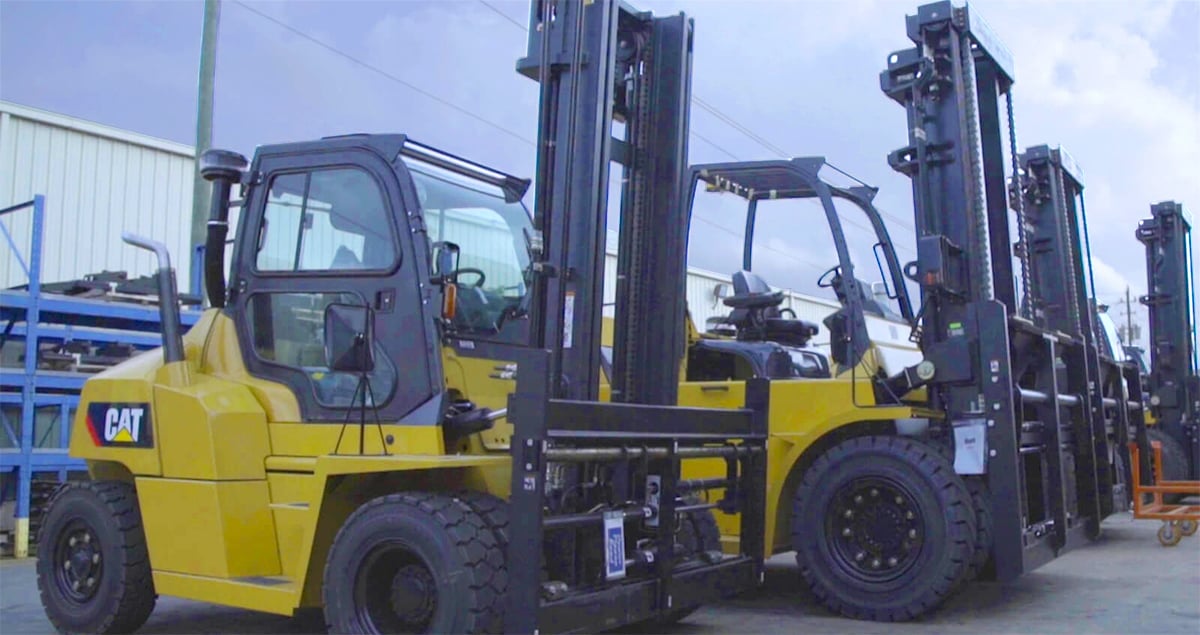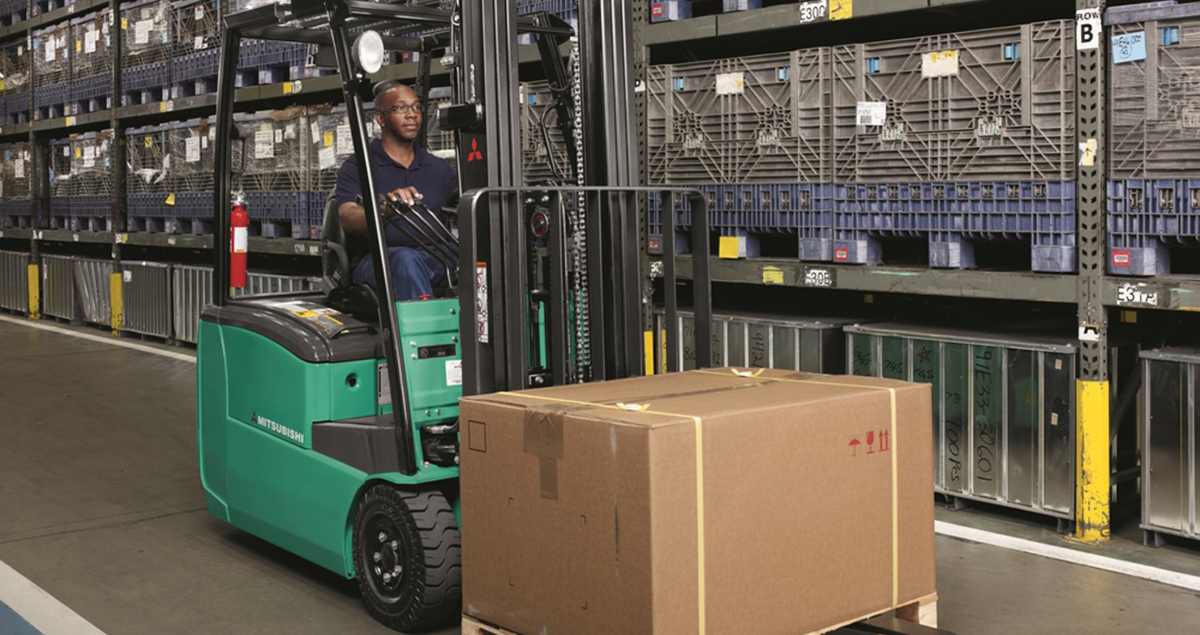Forklifts as microcosm of global economy

There's one little-known indicator that suggests the multi-year rally in the U.S. and the broader global economy still has legs.
In the face of concerns about overheated stock markets and policy uncertainty, one real-economy number should bring comfort. Forklift truck sales are beating all records and orders are likely to keep rising at least over the next two years to meet retail and warehouse demand, according to Mitsubishi Caterpillar Forklift America Inc. (MCFA, now Mitsubishi Logisnext Americas), one of the top makers and suppliers in the Americas.
"With the continued dramatic growth of e-commerce and online shopping" for groceries, household items, clothing and other goods, the retail industry is adapting to add more warehouses and logistics centers, Ken Barina, President of MCFA, said in an interview. Meanwhile, "the forecast for U.S. warehouse building growth exceeds economy in general -- over 10% per year in 2017 and 2018."
For the broader economy, it means two things: consumption remains healthy and companies appear ready to boost capital expenditure. Continued expectation for double-digit growth in e-commerce is also a boon for the manufacturing sector as retailers require more packaging, transport and supply chain services.
Bigger Than the Sum of its Parts
As an example of the above, take the forklift truck. Each job in the forklift industry supports 2.5 additional jobs in other sectors of the U.S. economy, extending the industry's impact to more than 209,000 American jobs, according to research by the Industrial Truck Association (ITA) and Oxford Economics, published in 2017.
Including taxes, wages, and payments to parts and other suppliers, the industry contributes annually more than $25 billion to the U.S. gross domestic product, the researchers found. That's about the same as the entire GDP of Paraguay, Yemen or Latvia.
With retail sales across the globe likely to top $27 trillion in 2020, from about $22 trillion in 2016, according to market research from eMarketer, we should expect the forklift and other manufacturers to reap the benefit. This is especially the case as much of the retail growth will be online, whose share of total sales still sits at a surprisingly small 9 percent in the U.S. and 12 percent in the U.K., eMarketer data shows.
More than just a mirror for the e-commerce boom, however, the forklift industry is a good demonstration of how manufacturing innovation stimulates economic activity.
While online purchases were a large reason for the post-recession high of 225,534 truck units sold in the U.S. in 2015, and about 1 million units sold globally, the other major driver for sales in the sector has been a shift to eco-friendly and tougher, all-weather technologies.

Improvements in battery life of machines such as MCFA's Jungheinrich electric forklifts, which allows them to work more than 2 shifts on one battery charge, is winning positive testimonies from customers that see a 10 percent to 15 percent increase in the volume of freight that an operator can handle. This comes at a time when distribution centers are being asked by retailers to only employ machines that do not emit greenhouse gases.
Better performance together with tighter environmental regulations have seen electric truck sales jump more than 8 percent in 2015, compared with a year earlier, to represent over 63 percent of all forklifts sold in North America, according to the ITA and Oxford Economics report. Many customers even require emissions tracking as a prerequisite to being a supplier due to concern over exhaust fumes contaminating food, the report said.
"The industry has made a noticeable shift to the use of electric forklifts. MCFA, too, is expanding its electric product manufacturing capacity in North America to meet market demand through new technologies," Barina said.
MCFA is a joint venture between two engineering giants, Caterpillar of the U.S. and Mitsubishi Heavy Industries (MHI) of Japan. Germany's Jungheinrich forklift brand joined the U.S.-Japan partnership in 2010 through a manufacturing and distribution agreement.
All Power to the Client
MCFA is driving advancements in power and battery performance to better serve its customers. As well as providing strong aftermarket service and support, and a full product line, which contains trucks that can operate both indoors and outside, MCFA has focused on delivering the kind of innovations that help clients boost productivity.
For companies such as Richardson Milling, the largest oat miller in North America, it meant having equipment at its South Sioux City, Nebraska processing facility that could move more than 380 tons of raw oats per day. The trucks Richardson needed had to lift weights of up to 2,500 pounds (1,133 kilograms) as high as 503 inches (12.8 meters), while keeping the drivers comfortable and safe.
Not only did MCFA meet the technical challenges, all while offering a battery that would still be 70 percent to 80 percent charged after a full shift, the supplier also installed a semi-automated Warehouse Navigation System at the Nebraska facility, according to Richardson's operations analyst, Kurt Eriksen.
MCFA's Jungheinrich Warehouse Navigation system uses data from the client storage facility to identify product locations and allow operators to delegate forklift movements to the machine, which can pick the most efficient route through the aisles in a similar way to how Google Maps might pick out the shortest driving route.
"Warehouse Navigation takes a lot of time out of loading and unloading product from the racks," Eriksen said in a testimonial. "It's improved our efficiencies as far as period-end counts. We know exactly what we have in the racks; where it's located. It's reduced our cycle count times by a great deal."
According to MCFA, customers can improve their productivity by up to 25 percent with the use of the intelligent-navigation and product tracking system.
Smart Forklifts Know the Way
The move toward these so-called Semi-Automated Guided Vehicles reflects the trend for companies to wring out efficiencies in their supply chain and distribution in order to cut costs and expand global trade. Storage spaces are being built ever more compactly, which gives lift trucks little room to navigate.
In addition, automation can help reduce workplace accidents by training sensors, cameras, and even lasers to "navigate blind spots, avoid collisions with pedestrians, and steer around corners and within narrow aisles," according to the ITA and Oxford Economics report.
Greater automation, cost savings through longer battery performance or fuel efficiencies, and the push to create a more environmentally friendly workplace, rewarded through such certifications as the ISO 14001, are all contributing to sales of forklift trucks, which have been a U.S. factory staple for 100 years as of this year.

Growth in American and global forklift truck orders since the end of the 2009 recession shows that the economic recovery is well on track, and the U.S. is looking especially healthy.
The outlook is optimistic, notes MCFA.
"Customers are seeking ways to reduce costs, improve productivity and drive larger overall performance. We continue to develop new technologies and product innovations to provide more energy-efficient lift trucks," Barina said.
Learn more about products and innovations in material handling by MHI Group





